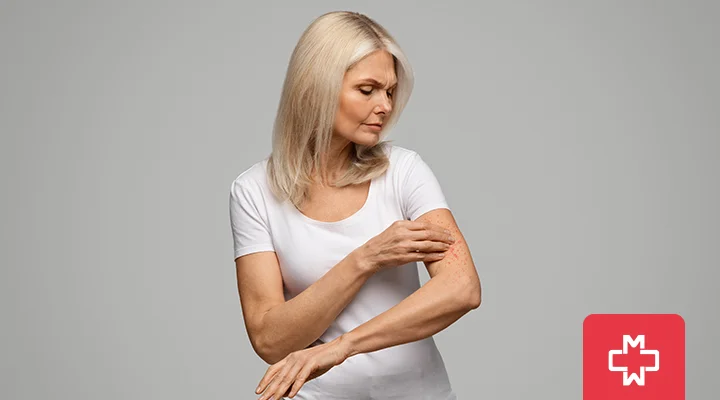Do you remember experiencing persistent, itchy red spots on your skin that had just appeared out of nowhere and stayed? – Those confusing and physically challenging red spots are known as Grover’s Disease.
Skin conditions can be puzzling as well as worrying – and one such enigma is Grover’s Disease. In today’s blog, we will explain the mysteries of grovers rash, exploring what it is, its symptoms, causes, and various grover’s disease treatment options.
What is Grover’s Disease?
Grover’s Disease, also known as transient acantholytic dermatosis, is a dermatological condition characterized by the sudden appearance of itchy red papules and plaques on the chest and back. It often poses a challenge for both patients and healthcare providers due to its unique presentation.
What Causes Grover’s Disease?
While the exact causes of grover’s rash are not known, there are a combination of factors that seem to contribute to its occurrence.
Here are the potential underlying causes of grover’s disease:
- Heat and Sweating: Grover’s disease often occurs in environments with excessive heat and sweating. The combination of heat-related stress and perspiration may lead to the eruption of red papules and plaques.
- Age and Demographics: This dermatosis is most commonly observed in older adults, particularly those over the age of 40.
- Genetic Predisposition: Individuals with a family history of skin conditions or a genetic predisposition may be more susceptible to experiencing grover’s rash.
- Underlying Medical Conditions: Individuals with a history of atopic dermatitis, immunosuppressive disorders, or other skin-related ailments may be more vulnerable to grover’s disease.
- Environmental Factors: Exposure to specific environmental factors, such as excessive sunlight or certain workplace conditions, may play a role in triggering grover’s rash.
- Compromised Skin Barrier: Conditions that weaken the skin’s protective layer are known to facilitate the development of grover’s rash and other skin problems.
Is Grover’s Disease Contagious?
No, grover’s disease is not contagious. It is a non-infectious skin condition, and its symptoms do not spread through contact with affected individuals.
Symptoms of Grover’s Disease
Symptoms of grover’s disease can be very uncomfortable, and understanding these symptoms is important for timely diagnosis and effective management.
Here’s a list of symptoms that are associated with grover’s disease:
- Red Papules and Plaques: The hallmark of grover’s rash is the sudden appearance of small, red papules and plaques on the chest and back. These raised and often itchy lesions can also vary in size.
- Intense Itching: Itchy skin is a common grover’s disease symptom. The intense itching can range from mild discomfort to an unbearable sensation.
- Transient Nature: Grover’s disease is appropriately named for its transient nature. The symptoms come and go, with periods of exacerbation followed by spontaneous remission.
- Potential Complications: In some cases, grover’s disease may also lead to complications such as secondary infection or even blisters.
- Variability in Presentation: While chest and back are the primarily affected areas, grover’s rash can occasionally present on other parts of the body as well.
How is Grover’s Disease Diagnosed?
Diagnosing grover’s rash requires a comprehensive approach, as its symptoms are similar to other dermatological issues.
Healthcare professionals carry out a combination of clinical examination, medical history review, and diagnostic tests to accurately identify grover’s rash.
- Clinical Examination: The first step involves a thorough clinical examination by a dermatologist. The distinctive red papules and plaques, along with their specific distribution on the chest and back, are key elements guiding the diagnosis. The appearance, location, and characteristics of the skin lesions are assessed.
- Patient History: Detailed patient history is gathered. Information about the onset of symptoms, any triggering factors, and the patient’s medical history, including any pre-existing skin conditions, provide valuable insights into the nature of this disorder.
- Skin Biopsy: To confirm the diagnosis and rule out other potential skin disorders, a skin biopsy may be recommended. During this procedure, a small sample of affected skin tissue is extracted and examined under a microscope. The biopsy helps to identify characteristic features of grover’s rash, such as acantholysis (separation of skin cells) and other specific changes.
- Histopathological Examination: The extracted skin biopsy is subjected to histopathological examination, where a pathologist analyzes the tissue at a microscopic level. This detailed examination helps in confirming the diagnosis of grover’s rash by identifying the characteristic changes in the skin cells.
- Dermoscopy: Dermoscopy, a non-invasive technique, may be employed to examine the skin lesions more closely. It involves using a special magnifying tool to observe the skin’s surface, aiding in the identification of specific patterns associated with grover’s disease.
- Potassium Hydroxide (KOH) Testing: In some cases, healthcare professionals may conduct a potassium hydroxide (KOH) test to rule out fungal infections that can sometimes mimic the symptoms of grover’s disease. This simple test involves applying a potassium hydroxide solution to a skin sample, facilitating the examination for fungal elements.
Grover’s Disease Treatment
Let’s explore the diverse grover’s disease treatment strategies:
- Topical Therapies: Topical corticosteroids, often prescribed in the form of creams or ointments, can help alleviate itching and reduce inflammation. Calamine lotion or emollients may also be recommended.
- Oral Medications: For more severe cases or those resistant to topical treatments, oral medications such as antihistamines or corticosteroids may be prescribed. These medications work systemically to address the underlying inflammatory response contributing to grover’s rash.
- Phototherapy (Light Therapy): Phototherapy involves exposing the affected skin to ultraviolet (UV) light under controlled conditions. This grover’s disease treatment modality has shown promise results by reducing inflammation and promoting skin healing.
- Emollients and Moisturizers: Regular application of emollients and moisturizers helps maintain skin hydration, reducing the risk of flare-ups and minimizing discomfort associated with dry, irritated skin.
- Avoiding Triggers: Identifying and avoiding triggers that intensify the symptoms is a crucial aspect of grover’s disease treatment. This may include minimizing exposure to heat, avoiding tight-fitting clothing, and implementing measures to reduce sweating.
- Cooling Measures: Cool compresses or cool baths can provide relief from itching and may help soothe the skin.
- Systemic Medications: In certain cases, systemic medications such as retinoids or immune-modulating drugs may be considered for their potential effectiveness in grover’s disease treatment.
How To Prevent Grover’s Disease?
Here’s a guide on how to prevent grover’s rash and minimize the impact of its symptoms:
- Maintain Skin Hygiene
- Choose Breathable Fabrics
- Temperature Regulation
- Avoid Hot Showers and Baths
- Moisturize Regularly
- Sun Protection
- Stress Management
- Stay Hydrated
- Avoid Irritants
Conclusion
Being aware of all this information related to grover’s disease is important for anyone who is suffering from grover’s rash, or has any loved one going through this discomfort inducing skin condition – as it equips with the knowledge required to identify and timely opt for the best grover’s disease treatment option.
We also invite you to visit Manhattan Medical Arts for personalized care and expert guidance. Our dedicated team is committed to providing comprehensive dermatological services, ensuring you receive the highest standard of care.
Frequently Asked Questions
What triggers transient acantholytic dermatosis?
Grover's Disease can be triggered by factors such as heat, sweating, and environmental conditions that contribute to skin irritation.
Is Grover's disease an autoimmune deficiency?
No, Grover's Disease is not associated with autoimmune deficiency. It is a skin condition characterized by sudden-onset red papules and plaques.
How do you stop Grover's disease from itching?
Itching associated with Grover's Disease can be alleviated through other treatments like corticosteroids, antihistamines, and cool compresses. Consult a healthcare professional for personalized advice.
Is Grover's disease a fungus?
No, Grover's Disease is not caused by a fungus. It is a skin disorder with unique characteristics, and its exact cause is not fully understood.
When should I be worried about an itchy rash?
If the itchy spots persist or worsen, or Grover-like skin eruption is accompanied by other concerning symptoms such as fever or difficulty breathing, seek medical attention promptly. It's advisable to consult with a healthcare professional for an accurate diagnosis and appropriate treatment.
How is Grover's disease treated?
Grover's disease is treated with topical corticosteroids, antihistamines, moisturizers, oral retinoids, and antibiotics for infections. Cool baths and avoiding triggers can also help manage symptoms.
What severe symptoms can arise from Grover's Disease?
Severe symptoms of Grover's Disease may include intense itching, widespread rash, skin infections from scratching, and significant discomfort, potentially impacting daily activities and quality of life.
– Disclaimer –
This blog is for informational & educational purposes only, and does not intend to substitute any professional medical advice or consultation. For any health related concerns, please consult with your physician, or call 911.
-
About The Author
Dr. Syra Hanif M.D.Board Certified Primary Care Physician
Dr. Syra Hanif is a board-certified Primary Care Physician (PCP) dedicated to providing compassionate, patient-centered healthcare.
Read More







